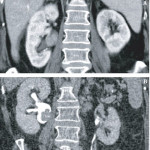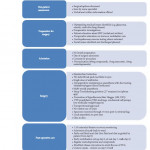Editorial: Speeding up recovery from radical cystectomy: how low can we go?
Radical cystectomy (RC) is the ‘gold standard’ treatment for muscle-invasive bladder cancer (BCa) [1]. It offers the best chance of cure in patients with curable disease and excellent palliation in those with local symptoms from advanced disease. Longitudinal reports suggest many patients accept and adapt to the impact of RC, leading to minimal overall impact on their quality of life [2]. As such, RC also offers a viable alternative to BCG for patients with high-risk non-muscle-invasive BCa. Whilst I recognize the vital role that chemotherapy and radiotherapy play in treating this disease, and that radiotherapy may be a better choice for some patients than RC, it is the morbidity from RC that hinders its wider use and encourages alternatives [3]. For example, studies in the USA show that up to one-third of patients with muscle-invasive cancers do not receive radical treatment [4], and implementation of centralized cancer services in the UK has only now shown survival improvements, as morbidity from RC comes down [5]. The lowering of peri-operative morbidity and mortality from RC is changing the face of the operation and increasing its use.
In this month’s issue of BJUI, Miller et al. [6] combine robot-assisted minimal access surgery with enhanced recovery to report outcomes in a consecutive series of ‘state-of-the-art’ RCs in their study from Exeter, UK. The authors show consistent improvements in outcome, such that length of stay halved over the duration of study recruitment. Importantly, recovery becomes more predictable (as shown by the converging mean and median length of stay figures), although it is unclear as to how many patients had prolonged stays. Whilst the authors should be congratulated for their efforts in delivering this service and for charting its implementation so meticulously, some key descriptive findings are missing. For example, what is the extent of the variation in their outcomes (range and quartiles) and do the data differ among surgeons? What happened to the 25% of patients who stayed longer than 10 days? Did all patients receive all components of their enhanced recovery programme, and if not, which were the most impactful? How did length of stay and complication rates differ by reconstructive choice and reconstructive location (intra- or extracorporeal)? Did patient selection stay the same over time, or did improved outcomes lower the ‘fit for cystectomy’ bar? Many of these answers will be missing, given that the primary source of information was the BAUS major operations registry. This self-completed dataset is extremely valuable for comparisons between units and trends over times, but has limited data complexity and granularity. Finally, whilst the field is moving towards total intracorporeal surgery, the reported complication rates appear similar for extra- and intracorporeal reconstruction, questioning the need for the added complexity of intracorporeal surgery.
Economists, commissioners and patients will want to know the importance of the forces driving these improved outcomes. Do the better outcomes reflect centralization of services, the team’s learning curve, the meticulous use of enhanced recovery or minimally invasive surgery through robotics? The latter has vastly different cost implications from the others. My guess is that, whilst all of these aspects were important, it was volume of service (from centralization) and enhanced recovery that were the main contributors. I speak having had a similar experience in my unit, although we started robotic surgery at a later date than did the present authors, and in the knowledge that this group previously published the dramatic impact of enhanced recovery on their length of stays after open RC [7].
Regardless of these concerns, the outcomes are to be welcomed by urologists and patients, and the team should be congratulated. As length of hospital stay becomes shorter, our next scientific focus should be on out-of-hospital recovery. We rarely see data on time taken to return to normal activity and on how patients adjust after surgery. Whilst return to work is important for younger patients, many patients with bladder cancer are retired so for these patients it is return to quality of life that matters most. This question becomes even more important in an era of centralized care, where many patients recover away from their surgical teams and, conversely, surgical teams are less aware of problems and outcomes. Perhaps it will be out of the hospital that the effort and cost of minimally invasive surgery are justified.



